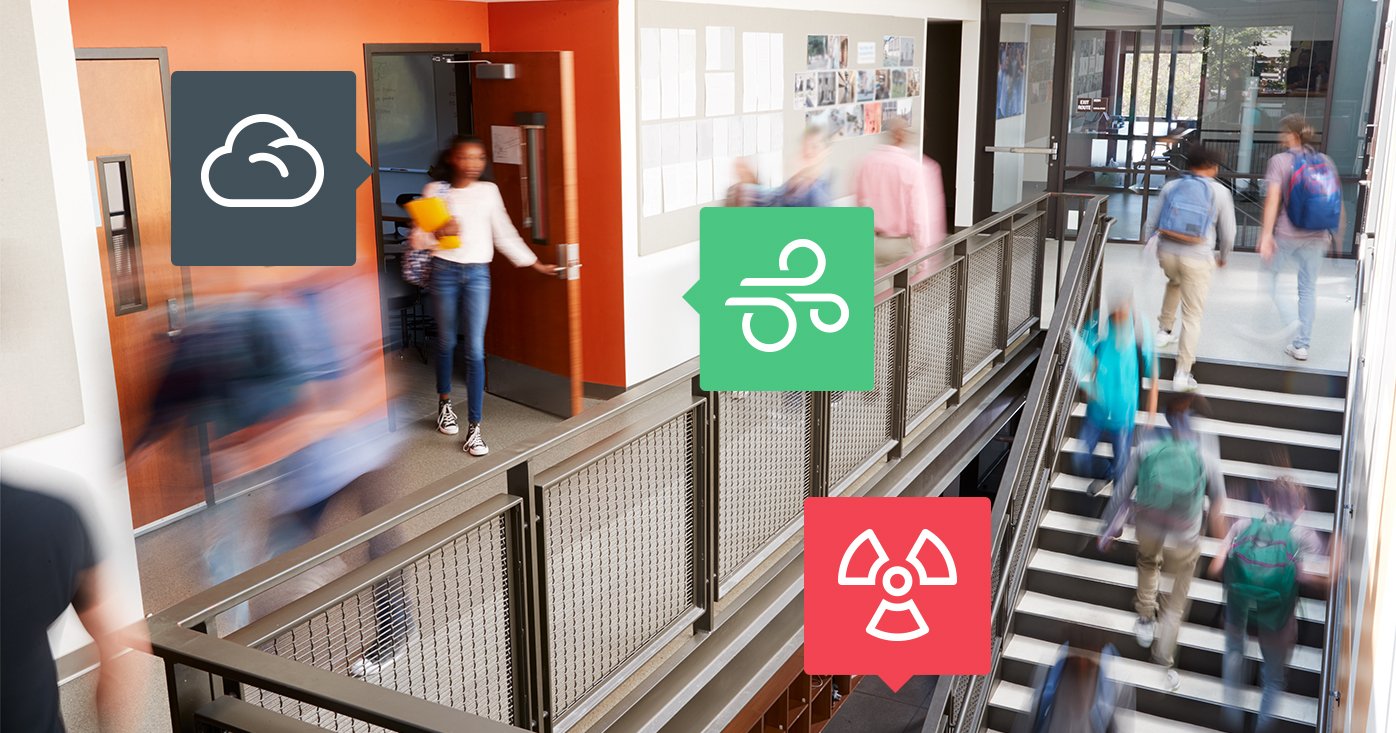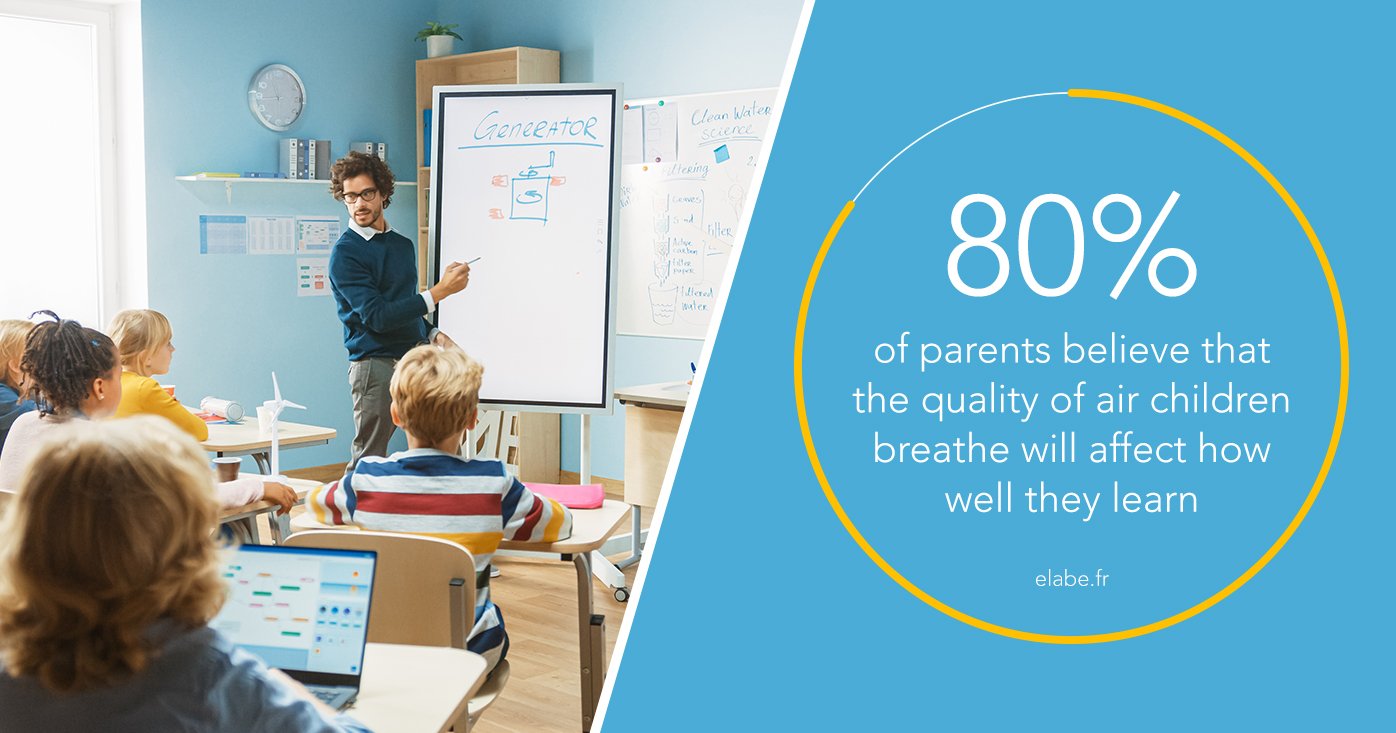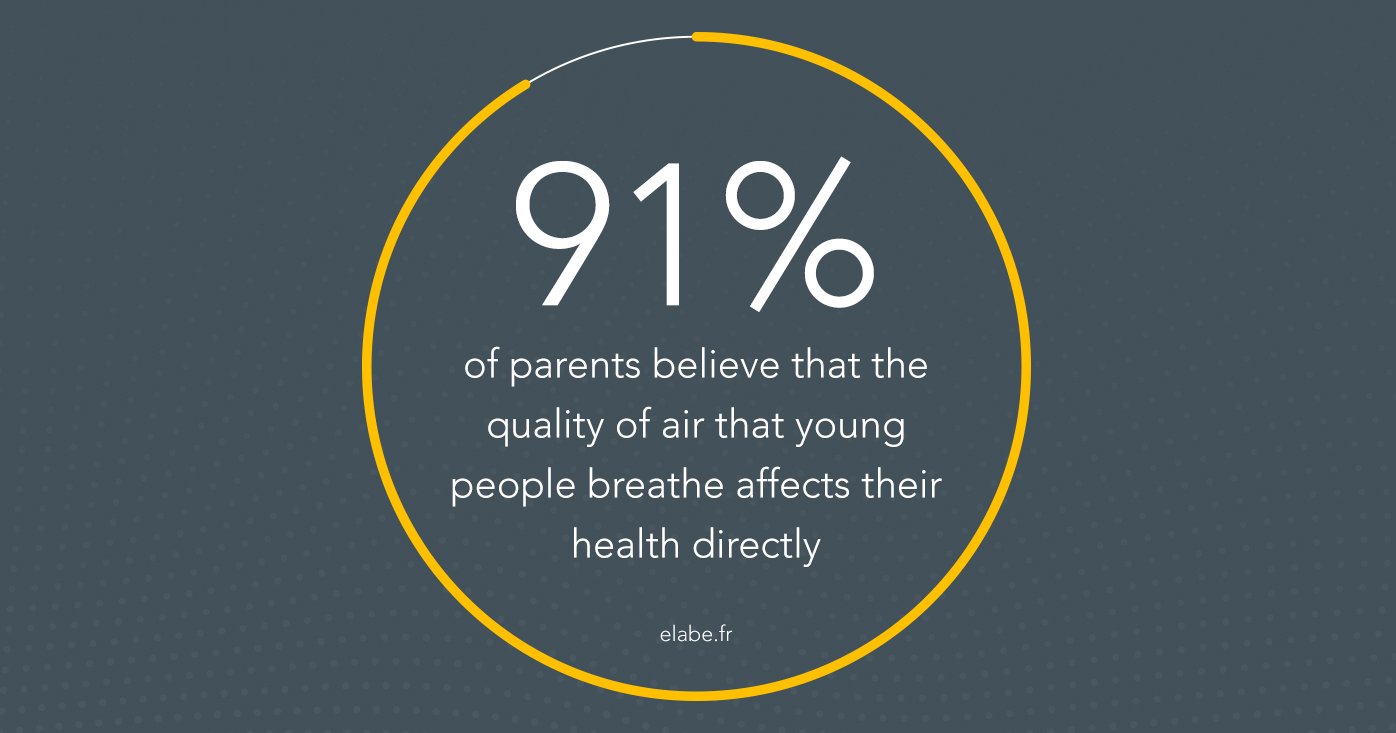Today, indoor air quality is at the forefront of every parent's mind. As their kids go back to school this fall, they have even more to worry about. New environmental dangers like pollution from wildfires and risk of disease transmission are all related to indoor air quality. This also impacts teachers and all school building occupants. To prevent the negative effects of stale indoor air and pollution, monitoring the levels in your building is key.

We spend 90% of our time indoors1, where the air can be up to five times more polluted than outdoors2. For children, a large portion of that time is spent in schools. Children are considered one of the more sensitive groups in regards to pollution. This is because their bodies are actively growing and they breathe higher volumes of air relative to their body weights than adults do.
Teachers too can suffer from loss of concentration from high carbon dioxide levels, drowsiness from high temperatures, or the increased risk of cold and flu transmission from poor humidity. When you measure and manage indoor air quality with a solution such as Airthings for Business, both students and staff are healthier, happier and more capable.
1.Encourage optimal learning and teaching
Taking steps to improve indoor air quality in schools has been shown to have a positive impact on key aspects of student performance. Concentration, engagement, and cognitive skills are just some of the benefits that can be gained. These are behaviors that translate to improved academic results, such as:
- Faster completion of numerical and language-based tasks among 10-12 year olds3.
- Better math and reading scores in elementary classrooms4.
- Faster and more accurate student responses for color, picture memory, and word recognition in primary schools.
Not only that, teachers and faculty also feel happier, healthier, and more valued; meaning they are fully present and much more likely to perform well.
Left unchecked, poor air quality will have the opposite effect. Factors such as high temperatures, too much carbon dioxide (CO2), lack of ventilation and rising humidity can all encourage lethargy and negatively affect how students and staff feel and perform.

2. Help support good health
According to a new report published by two respected medical bodies, not enough is being done to tackle the impact of air quality on the health of children and young people6. And it’s just one of a number of studies on the issue. We know, for example, that:
- High concentrations of CO2 have shown links to wheezing among children7.
- Poor indoor air quality in schools can be a severe health concern for those with asthma and allergies8.
- Indoor exposure too has been associated with “Sick Building Syndrome” in children, which is characterized by symptoms such as lethargy, headaches, and sore throats9.
- High humidity promotes the growth of bacteria10 and dust mites11 and the risk of respiratory illness and asthma symptoms12. On the other hand, low indoor humidity can cause symptoms, such as dry eyes and a runny or stuffy nose13, and is a leading cause of complaints in office environments14. It can also exacerbate the effects of indoor air pollutants such as PM and can help spread of viruses such as the flu and Covid-1915.
Although children are more susceptible to the health problems associated with poor air quality, everyone who works in the building is potentially at risk of symptoms ranging from asthma and eczema to impaired cognition16.
Not only that, air contamination levels indoors have been found to be up to five times higher than outdoors17.
Therefore, it makes sense for educational institutions to demonstrate leadership on this issue.
3. Improve attendance rates
No one wants staff or students to lose valuable time away from school, college or university due to an illness caused by poor air quality. If attendance drops, results are likely to follow suit.
By addressing air quality requirements, however, educators can help to prevent this by creating a healthier and more comfortable learning environment.
Increased ventilation rates in classrooms, for example, have been shown to help reduce student absence18. In addition better attendance has been associated with elementary and middle school students achieving higher grade point averages and higher scores on academic tests19. Again, good air quality is clearly linked with excellent student performance.

4. Demonstrate responsibility and duty of care
Parents and carers want the reassurance that the wellbeing of their children is a priority. 91% of them believe that the quality of the air students breathe directly impacts their health – a clear signal that healthy air in education is now a key part of these expectations20.
Employees are equally concerned about the issue. So much so, that many now value the working environment ahead of benefits and salary21.
5. Boost operational efficiency and sustainability
Smart solutions that track levels of CO2 – which is emitted naturally by breathing – provide a detailed picture of occupancy in different parts of the building throughout the day. With this information, key operational decisions can be made based on real-time and historical data. For example:
- Energy efficiency is improved; heating, ventilation, and air conditioning units are only switched on when classrooms, lecture halls or gyms are in use.
- Cafeteria catering can be closely aligned with actual student attendance each day to minimize waste.
- Cleaning schedules are coordinated to prioritize areas where high occupancy is recorded.
- Timetables are organized to make better use of available space.


6. Monitor air quality according to the recommendations
With so much attention on indoor air quality requirements, it is widely expected that new regulatory guidance will be introduced in the not too distant future. Air quality regulations are becoming stricter worldwide. New York City has already taken steps to ensure proper ventilation in all schools to ensure optimal indoor air quality for its students22. Educational establishments would be well advised to proactively take action on this issue now and commit to an air quality strategy designed to safeguard the wellbeing of both staff and students.
The CDC has released new guidelines about proper ventilation in schools to minimize the spread of Covid-1923. Opening windows and ensuring good airflow is key, but also increases risk of outdoor air pollutants entering the classroom, especially in cities with high concentrations of particulate matter. This is why continuous air quality monitoring of all contaminants as well as virus risk will be vital moving forward.
Evidently, air quality, especially carbon dioxide levels, temperature and airborne chemicals should be monitored in an educational setting by a reliable system such as Airthings for Business solution.
What you can do
A recent case study in Finland highlighted the importance of maintaining proper balance of air pressure in schools to ensure ideal indoor air quality can be maintained. By monitoring and altering the differential pressure, researchers were able to decrease levels of VOCs, PM, and harmful fungi inside the school while improving occupant’s perception of the indoor air quality24. In addition to monitoring indoor air quality with the Airthings for Business solution, you can now also integrate Balance for Business and data from our other products to automatically control the ventilation system in your school to adapt to changing environmental conditions.

Sources:
1.annualreviews.org/doi/10.1146/annurev-publhealth-031816-044420
2. epa.gov/iaq-schools/why-indoor-air-quality-important-schools
3.gwern.net/docs/co2/2015-stafford.pdf
4. pubmed.ncbi.nlm.nih.gov/21029182/
5.worldgbc.org/sites/default/files/Better%20Places%20for%20People%20-%20Schools%20Briefing%20Notes%20-IAQ.pdf
6.rcpch.ac.uk/resources/inside-story-health-effects-indoor-air-quality-children-young-people
7. ink.springer.com/epdf/10.1007/s00431-014-2288-4?shared_access_token=5JB_xa0uG7FD5uen-9eiSve4RwlQNchNByi7wbcMAY6hocqMd5aXw6L5I6iA6lbgpVDfP8Ht_iVzMNejK_wtZ0sQRPJomvNNixxziPcQsUOj85BdTw0iSsYWoep8gzdGOmXsdeooiuoTRaohmxiZXjO3ixPu_-WXuIP2QmLbEn
8.aafa.org/healthy-settings-schools-child-care-workplace-housing-restaurants-airlines/
9.worldgbc.org/sites/default/files/Better%20Places%20for%20People%20-%20Schools%20Briefing%20Notes%20-IAQ.pdf
10. https://www.tandfonline.com/doi/abs/10.1080/23744731.2016.1206430
11. https://www.niehs.nih.gov/health/topics/agents/allergens/dustmites/index.cfm
12. https://www.sciencedirect.com/science/article/pii/S0360132321002912?via%3Dihub#bib18
13. https://www.sciencedirect.com/science/article/pii/S0160412018320725#bb0285
14. https://www.sciencedirect.com/science/article/pii/S1438463917306946
15. https://www.nature.com/articles/s41598-021-89078-7
16. pubmed.ncbi.nlm.nih.gov/21621987/
17. https://www.huffpost.com/entry/how-employee-productivity_b_5620941?guccounter=1
epa.gov/iaq-schools/why-indoor-air-quality-important-schools
18. https://www.ncbi.nlm.nih.gov/pmc/articles/PMC3893609/
19.https://ehp.niehs.nih.gov/doi/10.1289/ehp.1510037
20. https://elabe.fr/wp-content/uploads/2019/09/veolia_qai_ecoles_rapport_sept2019.pdf
hrnews.co.uk/keeping-up-with-the-millennials-a-third-of-employees-choose-jobs-based-on-the-office-environment/
21. http://hrnews.co.uk/keeping-up-with-the-millennials-a-third-of-employees-choose-jobs-based-on-the-office-environment/
22. https://www.schools.nyc.gov/about-us/reports/building-ventilation-status
23. https://www.cdc.gov/coronavirus/2019-ncov/community/schools-childcare/ventilation.html
24. https://www.mdpi.com/1660-4601/15/2/230/htm
 Most popular
Most popular
 NEW
NEW




 Radon
Radon
 Radon
Radon


.webp)








